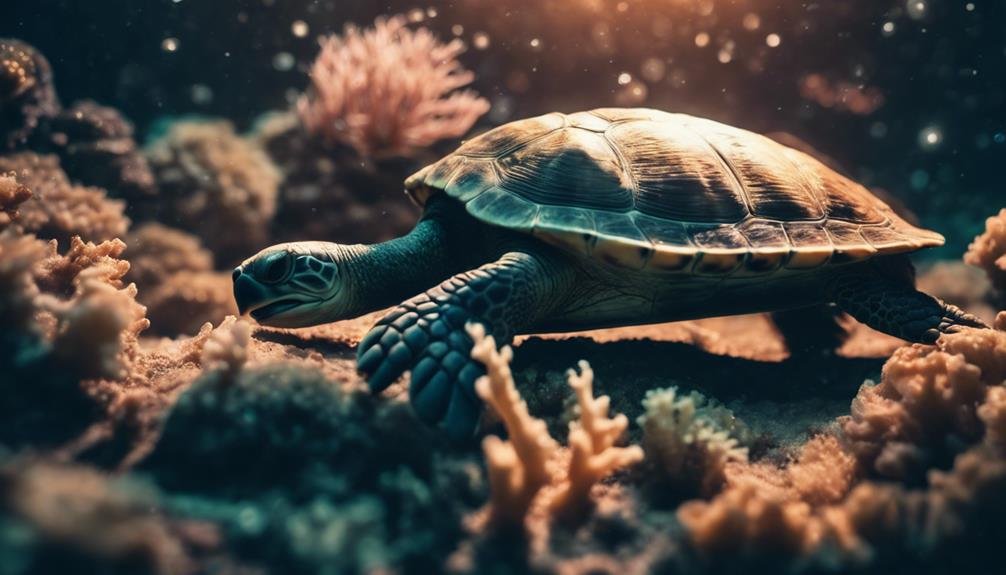Have you ever wondered how turtles manage after the sun goes down? It’s a common misconception that these creatures are helpless in the dark, but their night vision tells a different story. Turtles possess unique adaptations that allow them to see in low-light conditions, moving through their environment with an ease that might surprise you. From the intriguing redness gene to their underwater sight capabilities, there’s a lot more to turtle vision than meets the eye. As we explore the balance between myth and reality, you’ll discover why proper lighting is essential for these fascinating animals, hinting at a deeper understanding of their nocturnal behaviors.
Key Takeaways
- Turtles adjust their vision for low-light conditions, allowing them to move and navigate efficiently in darkness.
- Their night vision capabilities enable them to identify shapes, patterns, and movements, aiding in hunting and security.
- Turtles possess color vision, distinguishing colors like red, yellow, and orange, which enhances their ability to find food in dim light.
- The CYP2J19 gene plays a crucial role in enhancing turtles’ color perception, particularly in red-tinted aquatic environments.
- Proper lighting conditions are essential for turtles, with a balance of light and dark cycles supporting their health and natural behaviors.
Turtles and Darkness
In the cloak of darkness, turtles move with ease, thanks to their ability to adjust their vision to see shapes and objects clearly. As night falls, you might wonder how these creatures manage without the benefit of artificial light or the moon’s glow. Unlike humans, who might stumble or require a flashlight, turtles have evolved to thrive in low-light conditions. Their eyes adapt remarkably well to darkness, enabling them to discern their surroundings with surprising clarity. This ability is vital for their survival, especially when foraging or avoiding predators under the cover of night.
Turtles’ vision in the dark isn’t just about spotting a meal or steering clear of danger; it’s about exploring their environment with precision. They rely on detecting movement and silhouettes rather than the vivid color details visible in daylight. This skill sets them apart in the animal kingdom, especially among species that are active during twilight hours or nocturnal periods. While they don’t have true night vision in the technical sense, turtles’ adeptness in low-light scenarios showcases their remarkable adaptation to life in darkness, ensuring their survival and success in their natural habitats.
Turtles’ Night Vision
Exploring the depths of twilight, turtles exhibit night vision capabilities that rival or even surpass those of humans, allowing them to navigate their environment with ease. This incredible ability to see in the dark enables them to quickly identify shapes and patterns, essential for their survival. Whether it’s a sea turtle gliding through the ocean’s abyss or a terrestrial species maneuvering through dimly lit forests, their night vision plays a pivotal role.
Spending time in darkness isn’t just a matter of preference for these reptiles; it enhances their visibility, aiding in hunting and providing a sense of security. Some species, like the snapping turtle, are believed to have an even more refined low-light vision, giving them an edge over their prey and predators alike.
Turtles adapt to low-light conditions with remarkable efficiency. Their underwater vision is especially striking, as sea turtles can navigate murky waters and nighttime seas with dichromatic vision. This adaptation not only highlights their evolutionary success but also underscores the diversity of their sensory capabilities. As you explore the nocturnal world of turtles, it’s clear their ability to see in the dark is a testament to their resilience and adaptability.
Color Perception in Turtles
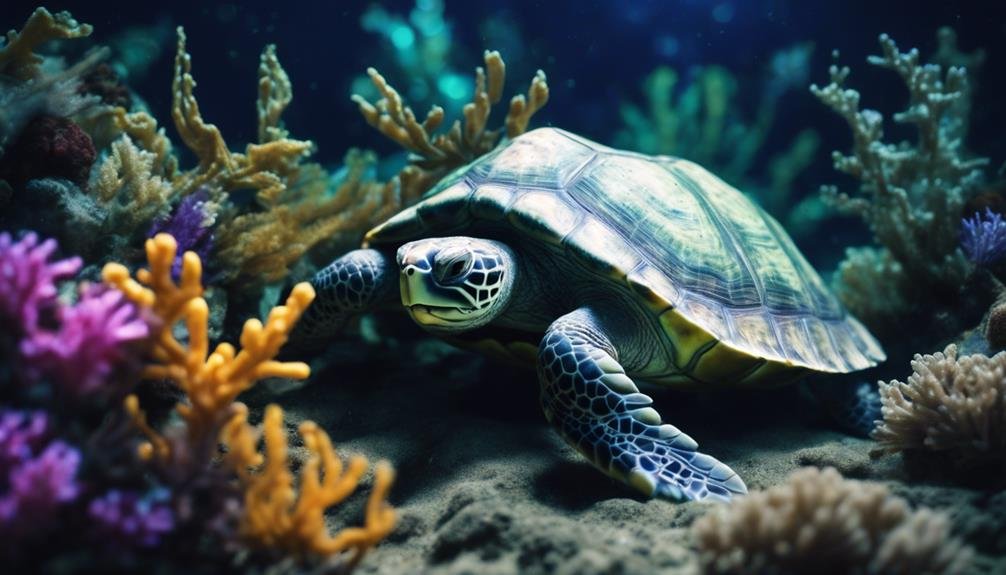

Turtles have the remarkable ability to see and distinguish colors, including shades of red, yellow, and orange, enhancing their interaction with the environment. This color vision isn’t just a vital trait; it’s a sophisticated feature that plays an essential role in how these creatures navigate their world. Thanks to the CYP2J19 gene, turtles can perceive these colors more vividly, particularly different shades of red. This genetic advantage isn’t just for show; it’s integral for their survival.
In the wild, turtles use their color vision to identify edible plants and animals. The ability to distinguish between vibrant colors helps them pick out food sources in their surroundings, from brightly colored fruits to camouflaged prey. But it’s not just about food; color perception is key to exploring and understanding their environment.
Moreover, turtles’ red-tinted vision is particularly beneficial in aquatic environments. This unique visual capability allows them to navigate murky waters with more ease, enhancing their ability to find food and avoid predators. By relying on color perception, turtles can assess and interact with objects in their environment more effectively, greatly boosting their visual capabilities in both terrestrial and aquatic settings.
The Redness Gene Explained
You’ve learned how turtles perceive colors, but have you wondered why they’re drawn to reds, yellows, and oranges?
This attraction stems from the CYP2J19 gene, which not only enhances their color vision but also influences their behavior.
Let’s explore how this gene plays an essential role in their ability to see and interact with their environment.
Gene’s Role in Vision
Due to the presence of the CYP2J19 gene, turtles can distinguish various shades of red, enhancing their visual experience. This redness gene is vital for their color perception, enabling them to differentiate between hues that humans might find indistinguishable.
The CYP2J19 gene plays a significant role in their visual behavior, especially when it comes to investigating objects. Turtles are naturally attracted to red, yellow, and orange colors, which is attributed to this gene’s influence. It not only aids in determining the edibility of objects based on color but also enriches their interaction with the environment.
Understanding how the CYP2J19 gene affects turtles provides valuable insights into their unique color perception abilities.
Impact on Turtle Behavior
By enabling the detection of red, yellow, and orange hues, the CYP2J19 gene greatly impacts turtle behavior, influencing their feeding habits and environmental interaction. This genetic adaptation not only enhances turtles’ vision compared to many other creatures but also plays a pivotal role in how turtles see underwater, an environment where these colors are essential for identifying prey and avoiding predators.
| Feature | Impact on Turtles | Relation to CYP2J19 Gene |
|---|---|---|
| Color Detection | Improved prey identification | Enhances ability to see reds |
| Environmental Interaction | Enhanced exploration | Facilitates better navigation |
| Underwater Vision | Superior compared to peers | Allows seeing in-between shades |
This unique capability ensures turtles have night vision advantages, enabling them to thrive in their aquatic habitats. Their ability to see underwater, especially in dim light, is greatly improved, making them adept hunters and navigators in their colorful world.
Turtle Vision: Myth Vs. Reality
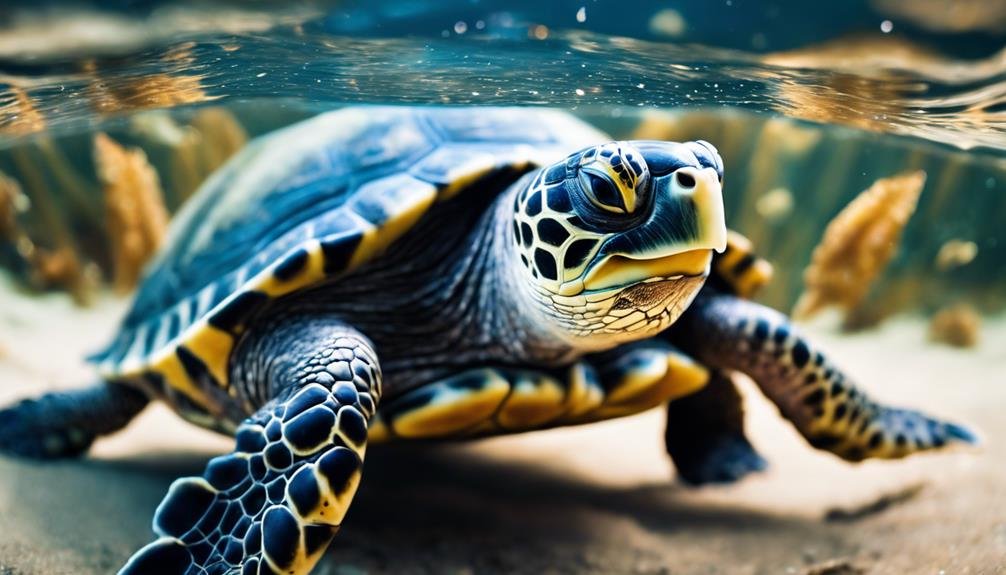

Dispelling myths about turtle vision reveals their remarkable ability to see almost as well in the dark as during daylight. Contrary to popular belief, turtles don’t possess the same night vision as nocturnal creatures that roam under the moonlight. However, they’re not entirely left in the dark either. Their visual acuity allows them to navigate and forage with ease even in low-light conditions, similar to us finding our way in a dimly lit room.
Turtles can’t see the vibrant range of colors we enjoy under the sun when it’s dark, but they can discern shapes and movements, ensuring they’re not vulnerable when the sun sets. This capability stems from specific visual mechanisms that adapt to darkness, supporting their exploration and feeding habits at night. It’s a common misconception that all nocturnal animals see perfectly in total darkness, but turtles, while not entirely nocturnal, showcase an impressive ability to adjust from a brightly lit environment to a darker one. Understanding this aspect of turtle vision highlights their adaptability and dispels the myths surrounding their nighttime activities.
Underwater Sight Capabilities
Turtles possess remarkable underwater sight capabilities, allowing them to see almost as clearly below the surface as they do above it. Thanks to their flat corneas and spherical lenses, they maintain clear vision whether exploring the depths of the ocean or basking in the sun. This unique eye structure is specifically adapted for underwater vision, helping sea turtles focus with precision in their aquatic environment.
When venturing through underwater territories, sea turtles rely on color vision to investigate objects around them. They show a preference for red, yellow, and orange shades, which stand out in the aquatic landscape. This ability to discern colors aids them in identifying food and navigating through coral reefs or seagrass beds.
Maintaining the clarity of tank water is essential for pet turtles to keep their underwater vision sharp. Regular cleaning prevents vision impairment, ensuring they can explore their environment without hindrance. Additionally, despite the low light visibility in deeper waters, sea turtles need only a minimal amount of light to navigate effectively. Their specialized eyes are well-equipped for exploration, enabling them to thrive in the vast and varied underwater world.
Lighting for Pet Turtles
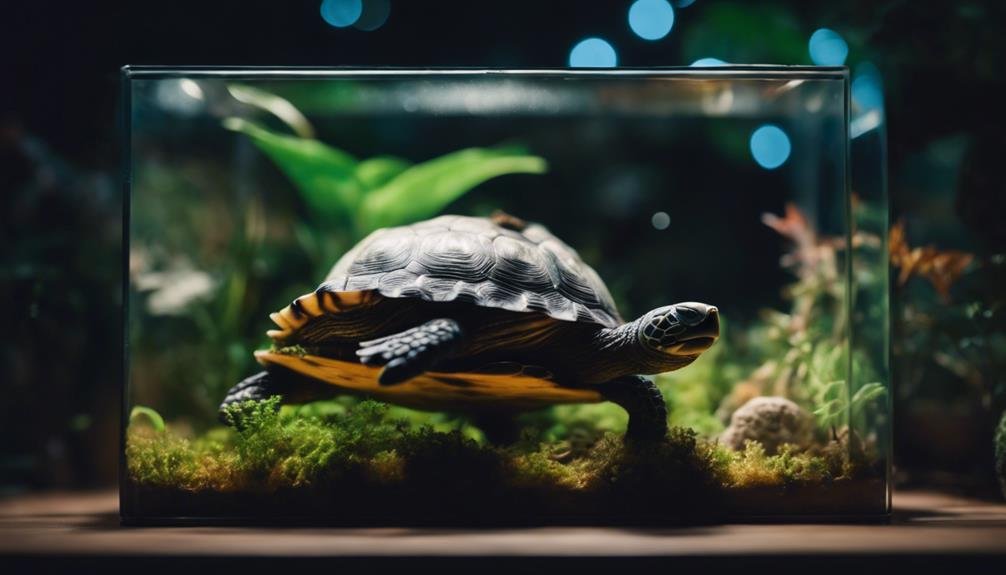

Understanding the underwater sight capabilities of turtles highlights the importance of proper lighting in their terrestrial environment as well. For your pet turtles, who are primarily diurnal, mimicking natural light conditions isn’t just important; it’s vital for their health. Providing a UVB lamp for 10-12 hours of daylight guarantees they’re not just seeing better but thriving. This artificial sun boosts vitamin D3 synthesis, essential for bone health and overall well-being.
Remember, turtles don’t require light at night. In fact, a dark, quiet environment is what they need for proper rest. Constant exposure to light during the night can disrupt their natural sleep cycles, leading to stress and health issues. It’s about finding that balance to make certain your pet turtles have a habitat that mirrors their natural surroundings as closely as possible.
Adequate lighting during the day and a complete absence of it at night is key to maintaining the health and balance of pet turtles in captivity. It’s not just about letting them see better; it’s about allowing their bodies to function as they would in the wild, under the natural light of the sun.
Turtle Light Cycle Recommendations
How can you guarantee your pet turtle stays healthy and maintains a natural rhythm? Understanding and applying turtle light cycle recommendations is key to supporting their well-being. Diurnal turtles, in particular, require a carefully managed lighting schedule to thrive in captivity.
Here’s how you can create a conducive environment for your turtle:
- Ensure 10-12 hours of daylight: Mimic natural light patterns to promote a healthy lifestyle for your turtle.
- Provide exposure to UVB light: Essential for vitamin D3 synthesis, UVB light supports shell and bone health.
- Create a dark, quiet environment at night: This helps maintain your turtle’s natural sleep patterns, essential for their overall well-being.
- Avoid constant light exposure at night: To prevent disrupting your turtle’s rest and health.
- Implement a consistent lighting schedule: This supports their health and natural behaviors, making them feel more at home in their habitat.
Sea Turtles’ Nocturnal Behaviors
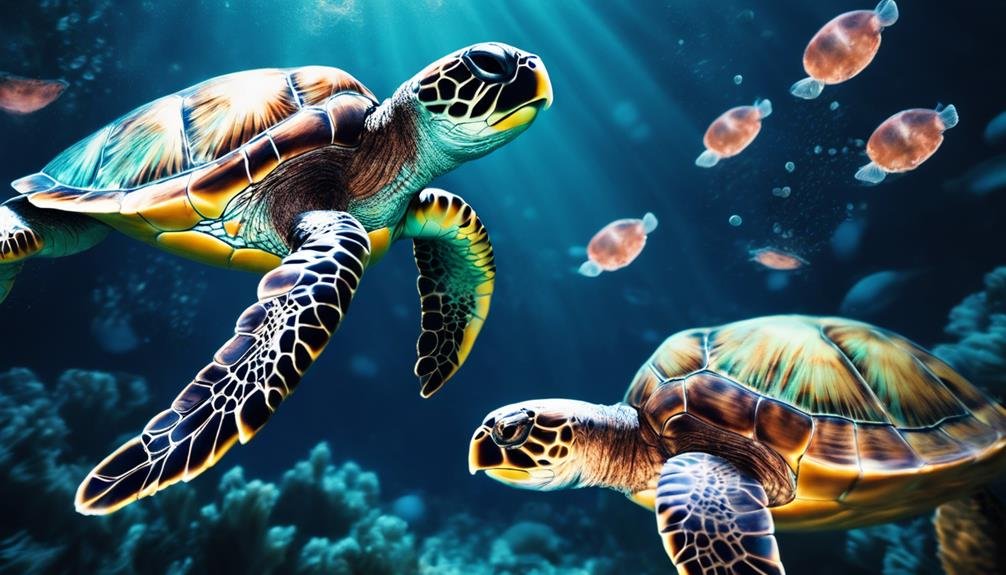

You might wonder how sea turtles manage their activities in the absence of sunlight. They’ve adapted to use the cover of night for both nesting on beaches and searching the ocean for food.
This nocturnal lifestyle not only helps them stay hidden from predators but also allows them to thrive in their natural habitats.
Nesting Habits at Night
Many sea turtles prefer to lay their eggs under the cloak of darkness, utilizing moonlit nights on sandy beaches to guarantee their offspring’s safety. This nocturnal nesting behavior isn’t just a preference; it’s a survival strategy. Here’s why:
- Nesting in the dark provides a natural cover, greatly reducing the risk of predation.
- Moonlit nights guide hatchlings towards the ocean, enhancing their chances of survival.
- The darkness offers a sense of security, allowing sea turtles to lay eggs undisturbed.
- Sea turtles have developed remarkable adaptations to navigate and nest in low-light conditions.
- These adaptations secure the survival of their offspring, demonstrating the intricate balance sea turtles maintain with their environment.
Nighttime Foraging Patterns
Under the cover of night, sea turtles engage in nocturnal foraging, skillfully using their heightened senses to locate prey in the dark waters. Their vital behaviors aren’t just a quirk but an essential survival strategy.
You’ll find these majestic creatures using their keen vision and sense of smell to hunt down food when the sun sets. This ability to navigate and feed in low light helps them avoid daytime predators and sidestep competition for meals, maximizing their feeding windows.
Especially for species like the loggerhead turtle, nighttime is when they’re most active, scouring the ocean for crustaceans, jellyfish, and other delicacies. This nighttime foraging pattern isn’t just about filling their bellies; it’s a necessary adaptation that cements sea turtles’ role as key predators in marine ecosystems.
Do turtles rely on their vision for swimming, especially in the dark?
Yes, all turtles can swim, and they do rely on their vision when swimming, even in the dark. Turtles have excellent night vision, and they use it to navigate through water and find food. However, their other senses, such as touch and smell, also play a crucial role in their swimming abilities.
Frequently Asked Questions
Do Turtles See in the Dark?
Yes, you’re wondering if turtles can see in the dark, right? Well, they do, but not like animals that are out and about all night. They’ve got a talent for spotting movement and can make out shapes and objects when it’s dim.
Don’t expect them to have eagle eyes in pitch black, though. Their ability to see drops as it gets darker, but they’re still pretty good at getting around with what little light they have.
Can I Leave My Turtle in the Dark?
You shouldn’t leave your turtle in complete darkness for too long. While they can see in the dark, it’s not ideal for their well-being. Extended darkness can mess with their sleep patterns and stress them out.
Aim for a natural day-night cycle, providing light and darkness. At night, a dim, quiet environment works best. If you need to observe them, consider a small night light or moonlight simulation to avoid disturbing their rest.
Can Turtles Find Their Way Around in the Dark?
Absolutely, turtles can find their way around in the dark. They’ve got a knack for detecting motion and adapting their vision to dim conditions, allowing them to make out shapes and patterns. This means they can navigate and even find food without much light.
Their behaviors, like nesting, also show they’re pretty savvy in low light. So, if you’re wondering, they’re quite adept at moving around even when it’s dark.
What Is a Turtles Vision Like?
You might wonder what a turtle’s vision is like.
Well, it’s pretty similar to yours, adjusting to darkness so they can nearly see as well at night as during the day.
Their underwater vision is just as clear, thanks to special adaptations. Plus, turtles can see more colors than humans, especially shades of red.
They’re drawn to bright colors like red, yellow, and orange, helping them decide if something’s good to eat.
Conclusion
So, you’ve learned that turtles can indeed see in the dark, thanks to their incredible night vision and color perception abilities. With the help of the redness gene, they’re not just surviving underwater and on land at night; they’re thriving.
It’s important to provide your pet turtle with the right lighting to mimic their natural environment and support their health. Remember, balancing their light cycle is key to keeping them happy and healthy.
Now, you’re equipped to make sure your turtle thrives, day and night.

